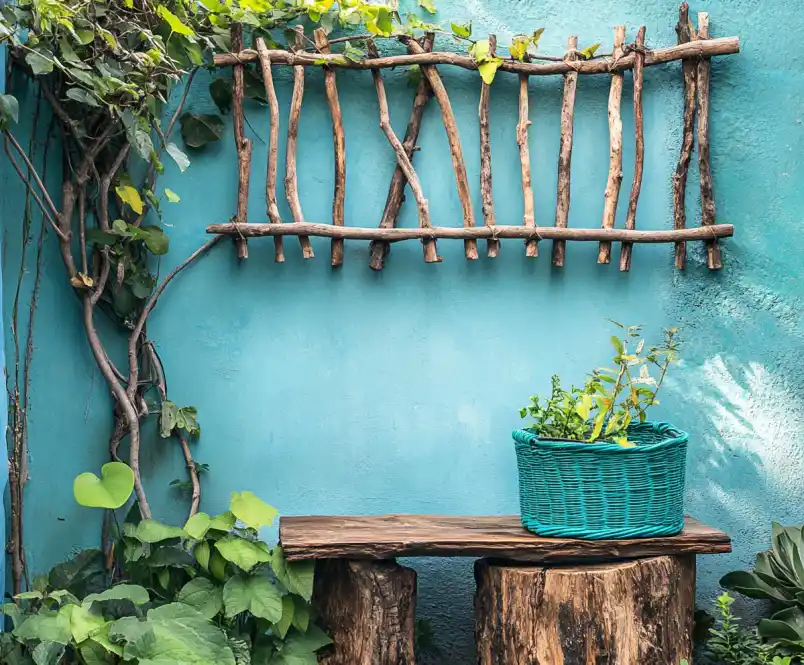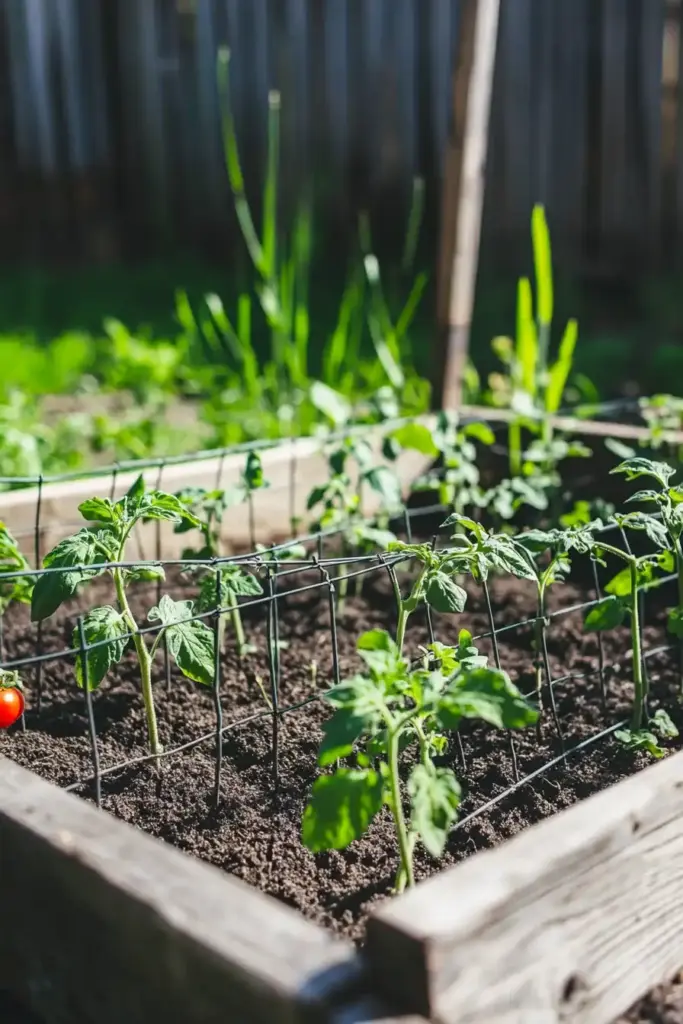Growing cucumbers vertically is one of the smartest ways to save space, boost yield, and keep your fruits cleaner and easier to harvest. Whether you’re working with a small garden bed, a few containers, or a full backyard plot, a DIY cucumber trellis is a must-have tool for vertical gardening.
In this guide, we’ll walk through 16 unique and beginner-friendly cucumber trellis ideas using materials like metal, wood, PVC, and even recycled items. Each section includes a material list, simple instructions, and the pros and cons to help you decide which trellis is right for your garden.
Let’s dive in!
1. Easy Metal Cucumber Trellis
Overview:
This simple and sturdy cucumber trellis uses metal fencing or wire mesh to create an efficient vertical support system. It’s perfect for gardeners looking for a durable solution with minimal upkeep.
Materials Needed:
- Metal fencing or welded wire mesh panel
- T-posts or metal stakes
- Zip ties or garden wire
- Hammer or post driver
Instructions:
- Choose a sunny garden spot and mark out your trellis line.
- Drive two metal stakes or T-posts into the ground, about 3–4 feet apart.
- Attach the metal fencing or mesh panel to the stakes using zip ties or garden wire.
- Make sure the structure is at least 5 feet tall to accommodate vining cucumber varieties.
Pros:
- Extremely durable and long-lasting
- Low maintenance
- Strong enough to support heavy cucumber loads
Cons:
- Requires tools and strength to install
- Metal can get hot in full sun, which may affect tender vines
2. Wood and Twine Raised Bed Cucumber Trellis
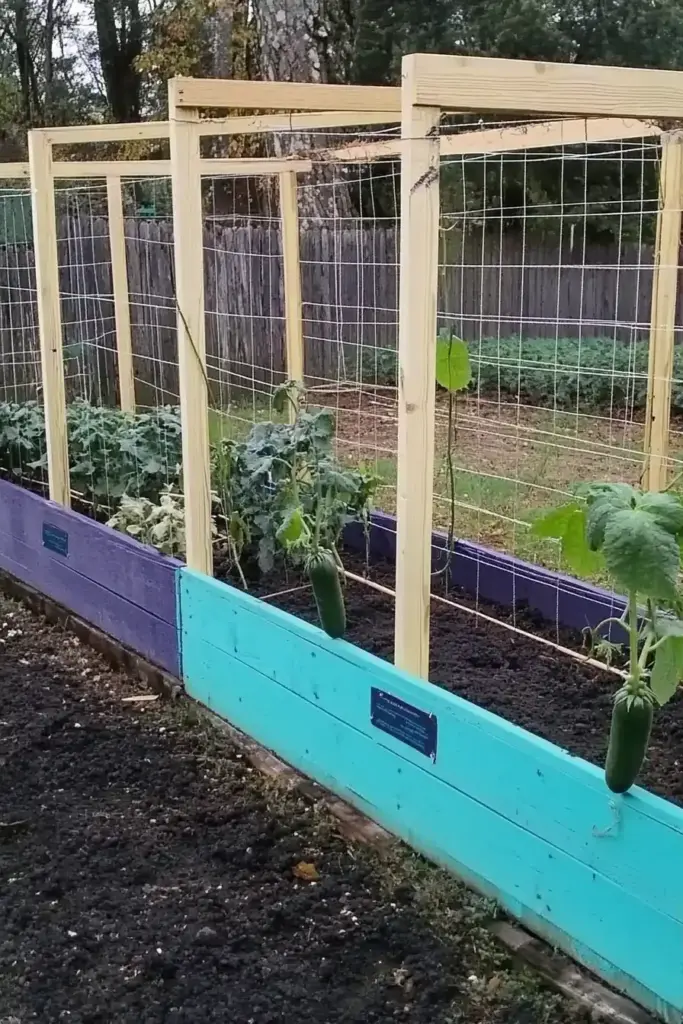
Overview:
Perfect for raised beds, this trellis uses wood posts and garden twine to form a supportive grid. It’s simple, effective, and budget-friendly.
Materials Needed:
- 2 wooden stakes or garden posts (5–6 feet tall)
- Garden twine or jute string
- Drill (optional) or hammer
- Nails, screws, or hooks
Instructions:
- Drive the wooden stakes into opposite corners of your raised bed.
- Create a crisscross or grid pattern with the twine by tying it horizontally and vertically between the posts.
- Make sure the twine is taut to support the cucumber vines as they climb.
Pros:
- Inexpensive and easy to build
- Great for raised garden beds
- Easy to dismantle and store
Cons:
- Twine may need replacing mid-season
- Not ideal for very heavy vines
3. Easiest Wood Ladder Cucumber Trellis
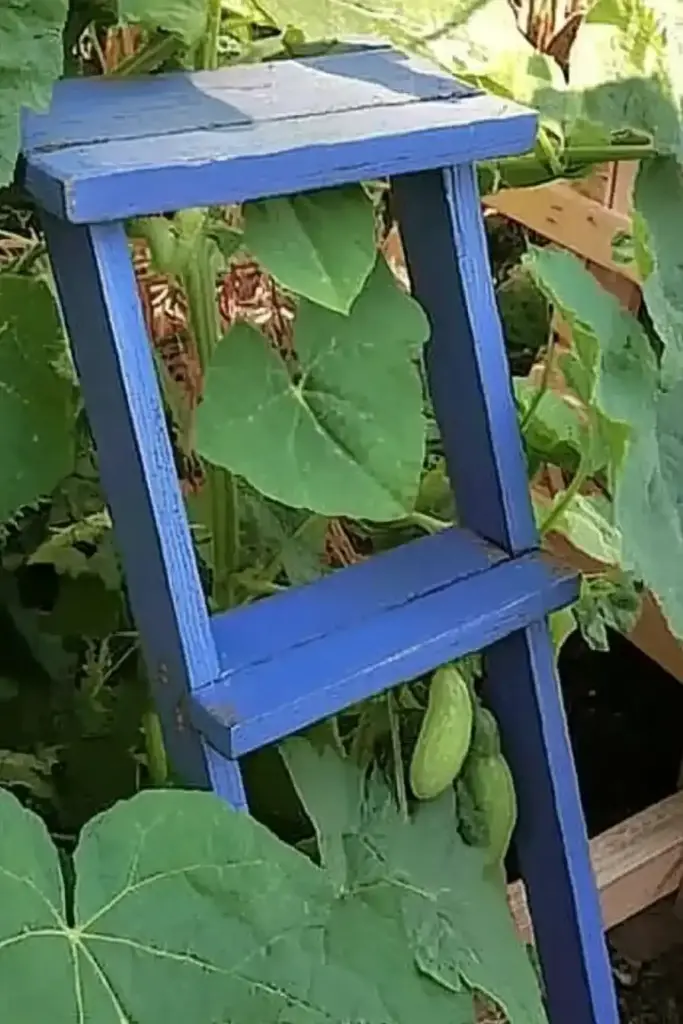
Overview:
Repurpose an old wooden ladder for a rustic, no-fuss cucumber trellis. This is a fantastic upcycling project with minimal effort.
Materials Needed:
- Wooden ladder (preferably step ladder style)
- Optional: twine or wire for additional support
Instructions:
- Clean the ladder and make sure it’s sturdy.
- Place it in your garden with the legs fully extended and secured in the soil.
- Wrap twine or garden wire across the rungs if extra climbing support is needed.
- Plant cucumbers at the base of each side and let them climb naturally.
Pros:
- Great way to reuse old materials
- Zero construction required
- Rustic garden charm
Cons:
- Can be bulky in small spaces
- Needs to be weatherproofed if left outside year-round
4. Wood Pyramid Cucumber Trellis
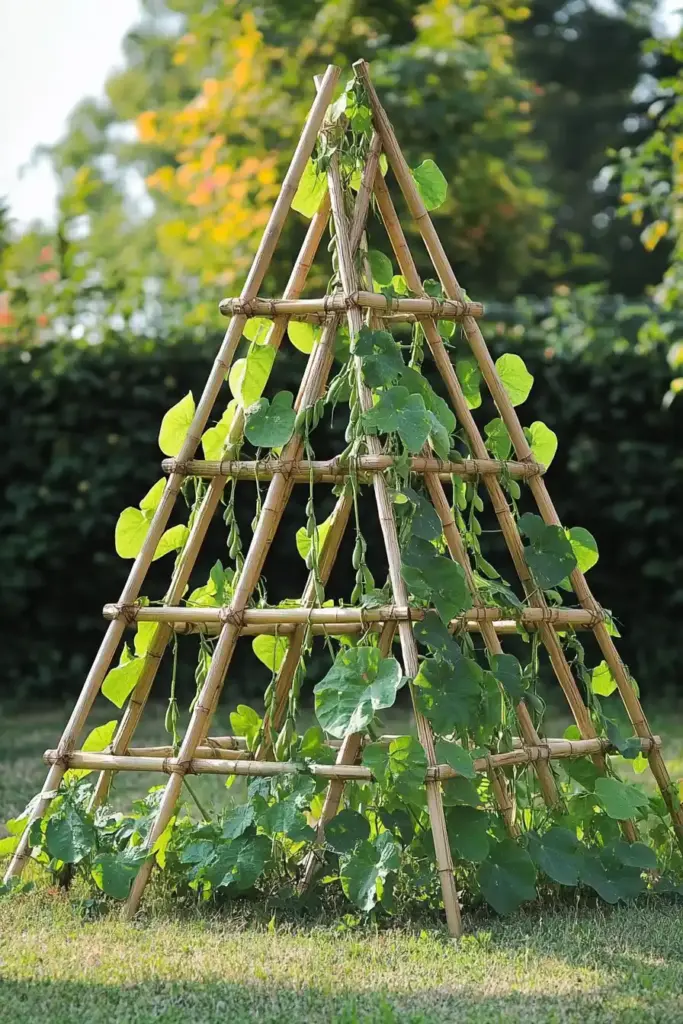
Overview:
This 3D trellis structure is shaped like a pyramid or obelisk, offering support on all sides—great for central placement in a garden bed.
Materials Needed:
- 4 long wooden poles or bamboo stakes
- Garden twine or small wood slats
- Drill and screws or zip ties
Instructions:
- Arrange four poles to form a pyramid shape, crossing them at the top.
- Secure the top with twine or screws.
- Add horizontal slats or wrap twine around the structure for the vines to grip.
Pros:
- Eye-catching and decorative
- Supports multiple plants at once
- Good air circulation
Cons:
- Takes more time to construct
- Can become top-heavy without proper anchoring
5. PVC Pipe Cucumber Trellis
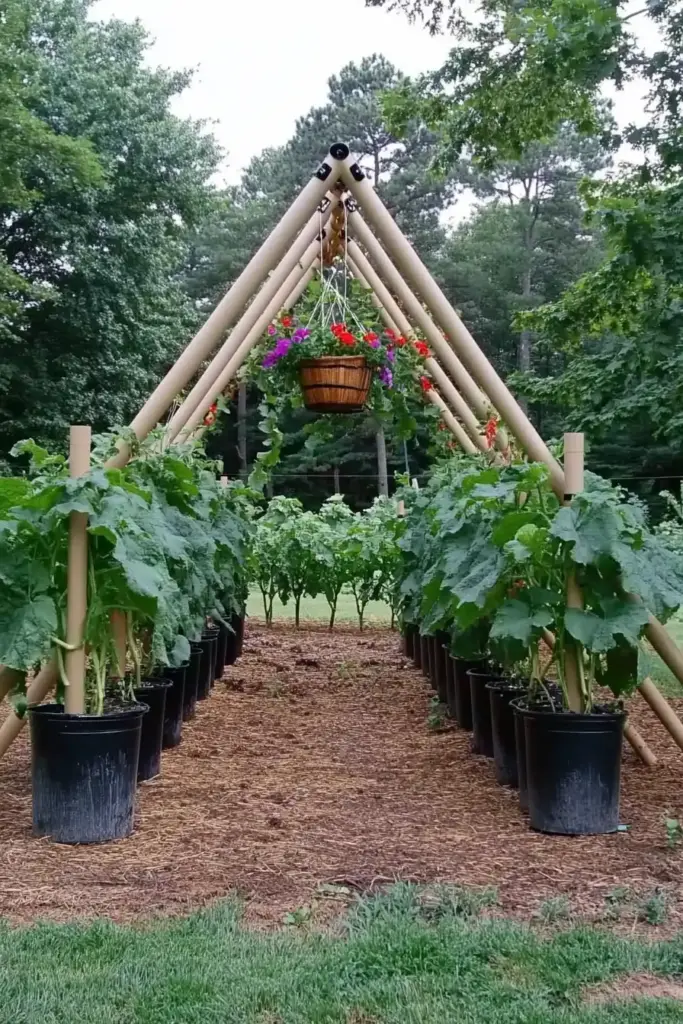
Overview:
Lightweight, weather-resistant, and affordable, a trellis made from PVC pipe is a smart choice for gardeners who want a semi-permanent, reusable structure.
Materials Needed:
- PVC pipes (1/2″ or 3/4″) and elbow joints
- Pipe cutter or saw
- Garden netting or twine
- Zip ties
Instructions:
- Cut your PVC pipes to form a rectangular or A-frame shape.
- Connect them using elbow joints to build your trellis frame.
- Attach garden netting or twine across the frame for climbing support.
- Anchor the base in the soil or to your garden bed.
Pros:
- Durable and weather-resistant
- Lightweight and portable
- Customizable size and shape
Cons:
- Requires cutting and fitting
- Not as rustic-looking as wood options
6. Simple Branches and Twine Cucumber Trellis
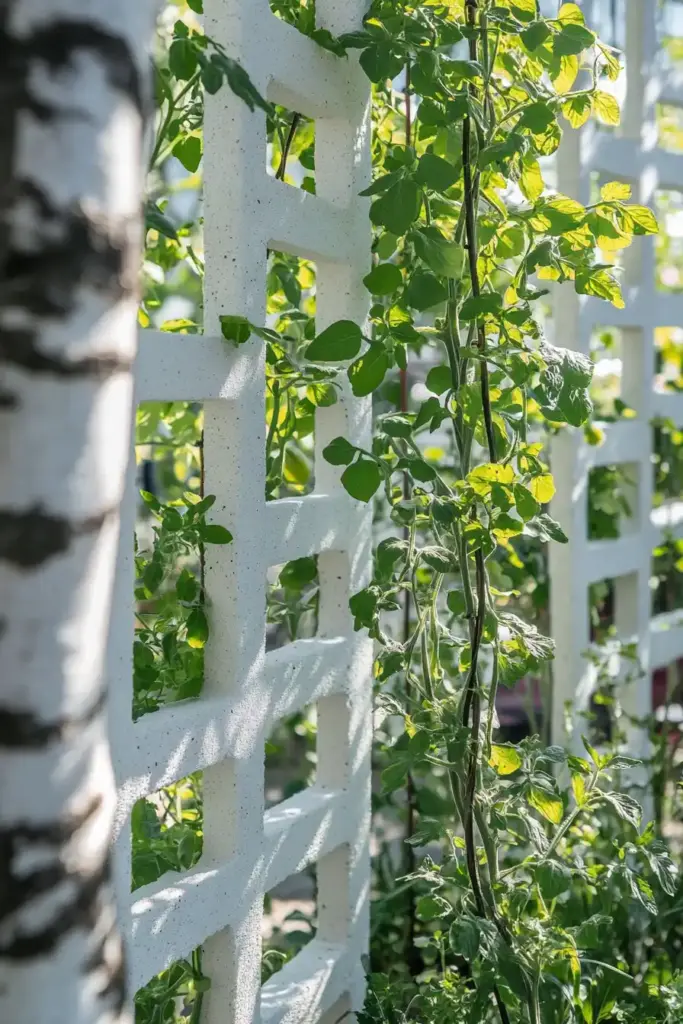
Overview:
This back-to-basics trellis idea uses pruned branches and string—ideal for gardeners who love a natural look and want to reuse yard waste.
Materials Needed:
- Tree branches or sticks (around 5–6 feet long)
- Twine, jute, or string
- Scissors or pruning shears
Instructions:
- Stick the branches vertically into the soil, forming a loose row or zigzag pattern.
- Wrap twine around the branches horizontally or diagonally, creating a web of support.
- Weave cucumber vines through the twine as they grow.
Pros:
- 100% natural and biodegradable
- Free materials if you have trees or shrubs
- Rustic, organic look
Cons:
- Less durable than wood or metal
- May require occasional tightening or replacement
7. Easy String Garden Cucumber Trellis
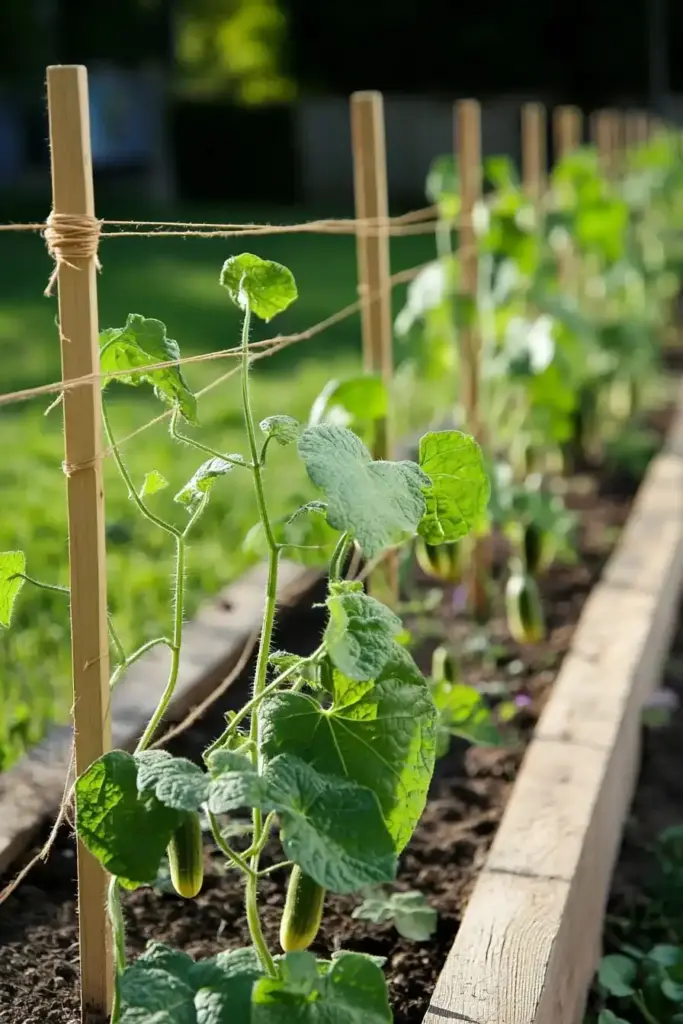
Overview:
This minimalist trellis involves string suspended between a top beam and the ground — a super easy solution for raised beds or small garden plots.
Materials Needed:
- Two tall wooden posts or garden stakes
- Horizontal wood beam (optional)
- Garden twine or string
- Nails or hooks
Instructions:
- Drive two vertical posts into the ground, then attach the horizontal beam across the top.
- Tie lengths of twine from the top beam to the ground, spaced every 6 inches.
- Train cucumber vines to climb the strings as they grow.
Pros:
- Simple, cheap, and effective
- Great for small or narrow spaces
- Easy to remove at the end of the season
Cons:
- Strings may sag with heavy fruit
- Not very wind-resistant without proper anchoring
8. Arched Metal Cucumber Trellis
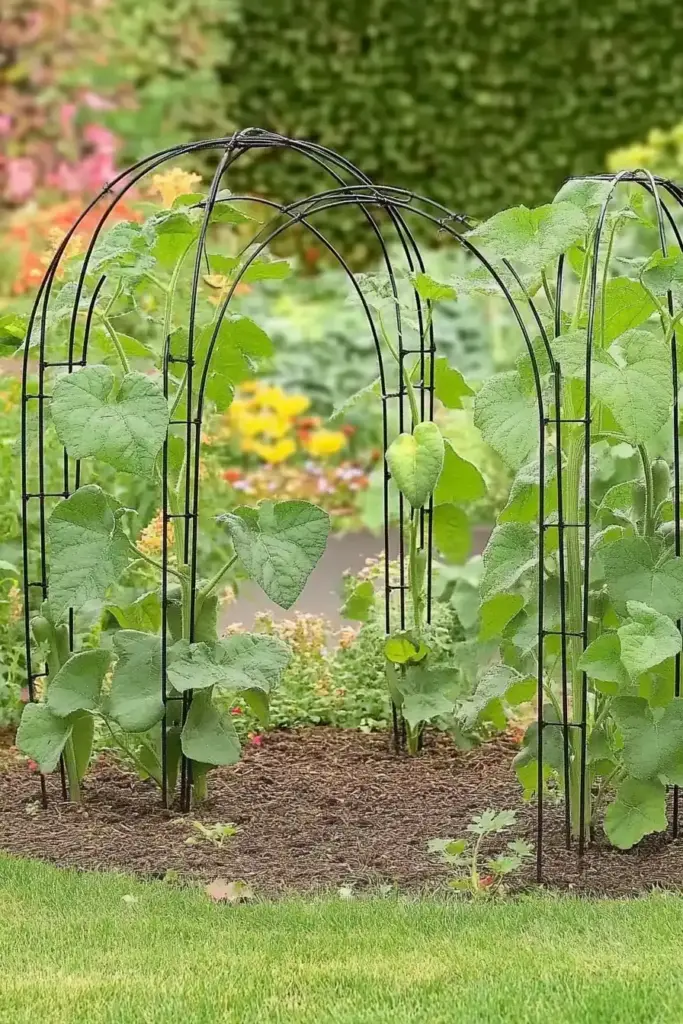
Overview:
Turn your cucumber patch into a magical archway! This design adds style and function by allowing cucumbers to hang from an overhead arch.
Materials Needed:
- Livestock panel or metal arch frame
- T-posts or strong garden stakes
- Zip ties or wire
Instructions:
- Bend the cattle panel or metal mesh into an arch shape and secure the ends in the ground or to raised beds.
- Use T-posts or stakes to stabilize each end.
- Plant cucumbers on both sides and train them to climb over the arch.
Pros:
- Doubles as a garden walkway or focal point
- Makes harvesting easy (fruit hangs down)
- Sturdy and long-lasting
Cons:
- Needs two people to install due to size
- Requires space for the arch footprint
9. Tee Pee Stakes Cucumber Trellis
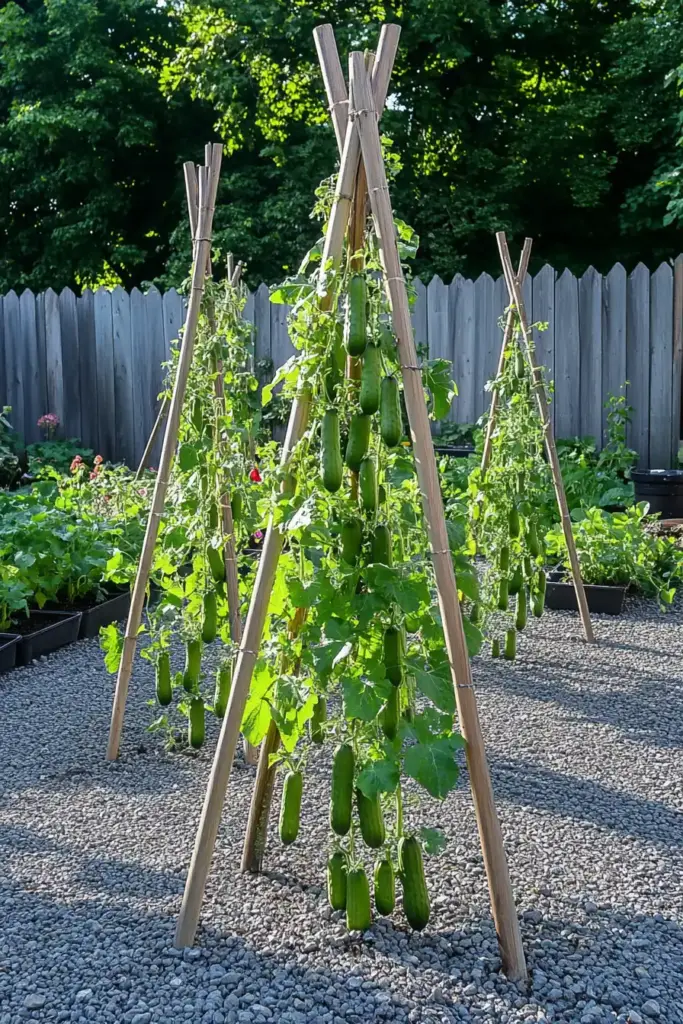
Overview:
This classic tripod-style trellis is easy to build with bamboo or wooden stakes. It’s perfect for creating a vertical growing space in a tight area.
Materials Needed:
- 3 to 5 tall bamboo stakes or wooden poles
- Garden twine or wire
- Hammer or mallet (optional)
Instructions:
- Push the stakes into the soil in a circular pattern, then lean them toward each other to form a teepee shape.
- Tie the tops together securely with twine or wire.
- Wrap additional twine horizontally around the structure for extra support.
- Plant cucumbers at the base of each stake.
Pros:
- Quick and simple to build
- Great airflow and light exposure
- A charming, natural look
Cons:
- May need anchoring in high winds
- Less stable for heavy cucumber varieties
10. Branches and Zip Tie Cucumber Trellis
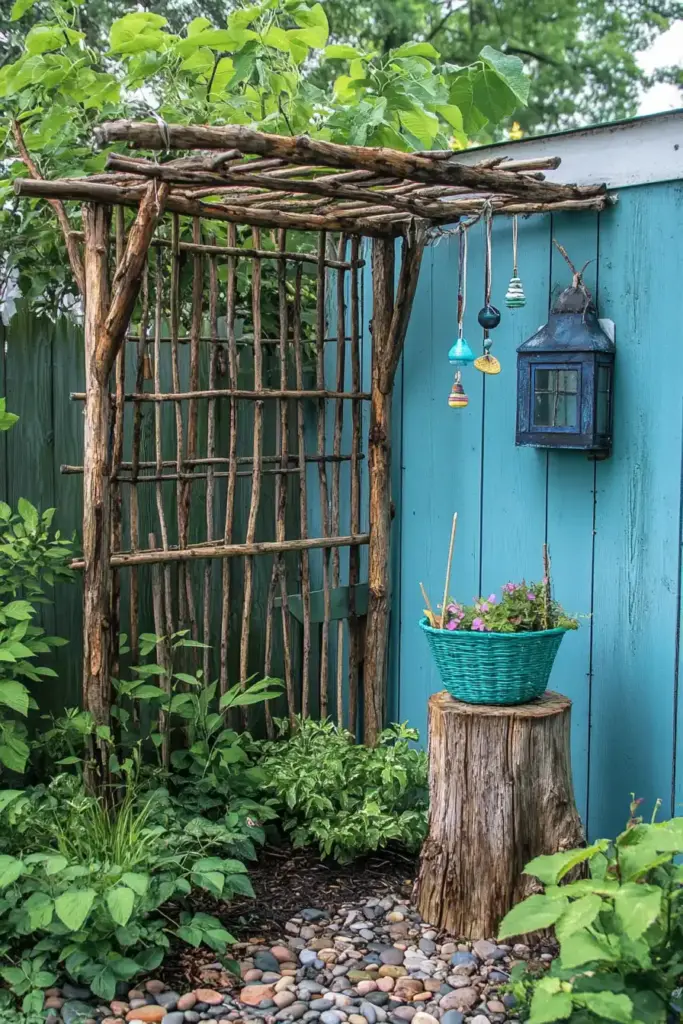
Overview:
Similar to the branches and twine trellis, but this version uses zip ties to increase durability and stability—ideal if you want something rustic yet secure.
Materials Needed:
- Long, sturdy branches or saplings
- Zip ties
- Garden scissors or pruners
Instructions:
- Create a frame using thick branches as uprights and crossbars.
- Secure the intersections with zip ties instead of string.
- Add diagonal or vertical support branches as needed for climbing.
- Plant cucumbers and guide them up the structure.
Pros:
- Eco-friendly with a stronger hold
- Easy to adjust or rebuild
- Customizable shape and size
Cons:
- Branches may weather over time
- Zip ties are not biodegradable
11. Rebar Cucumber Trellis
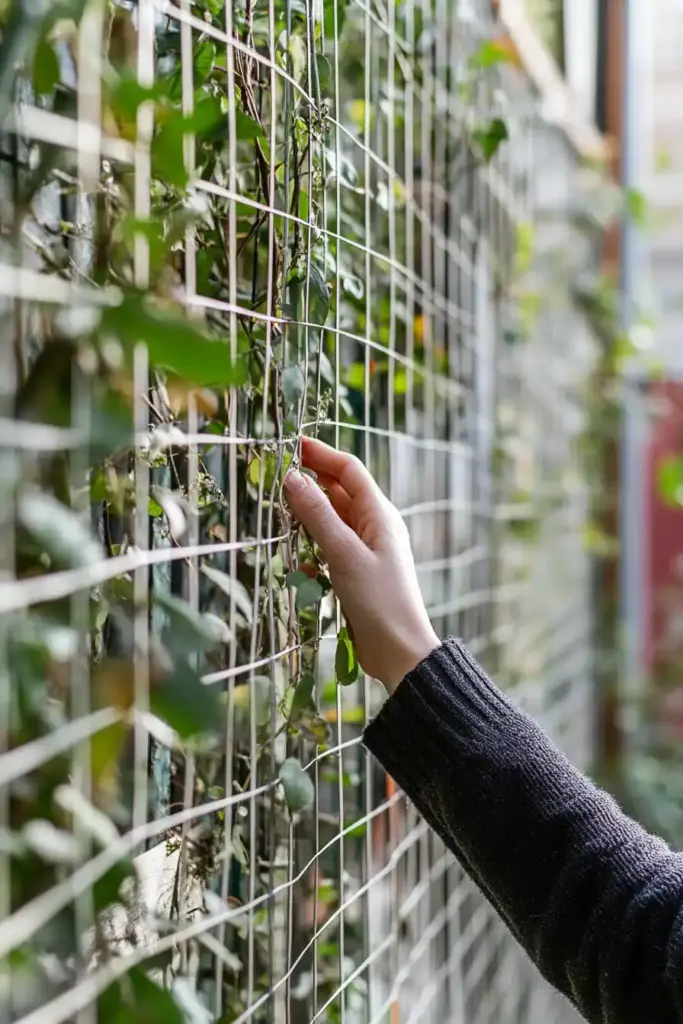
Overview:
This industrial-strength trellis uses steel rebar—ideal for heavy-duty gardeners who want a long-term solution with minimal fuss.
Materials Needed:
- Rebar rods (6–8 feet)
- Bolt cutters (if trimming)
- Zip ties or steel wire
- Drill (optional if mounting)
Instructions:
- Cut the rebar to the desired height and width.
- Create a rectangular frame or lean-to structure using rebar and connect pieces with wire or ties.
- Anchor the trellis securely into the ground or attach to a garden bed frame.
- Plant cucumbers at the base and train them to climb.
Pros:
- Extremely strong and durable
- Withstands wind and heavy fruit
- Long lifespan
Cons:
- Rebar can rust if not treated
- May require tools and effort to cut or bend
12. Cattle Panel Cucumber Trellis
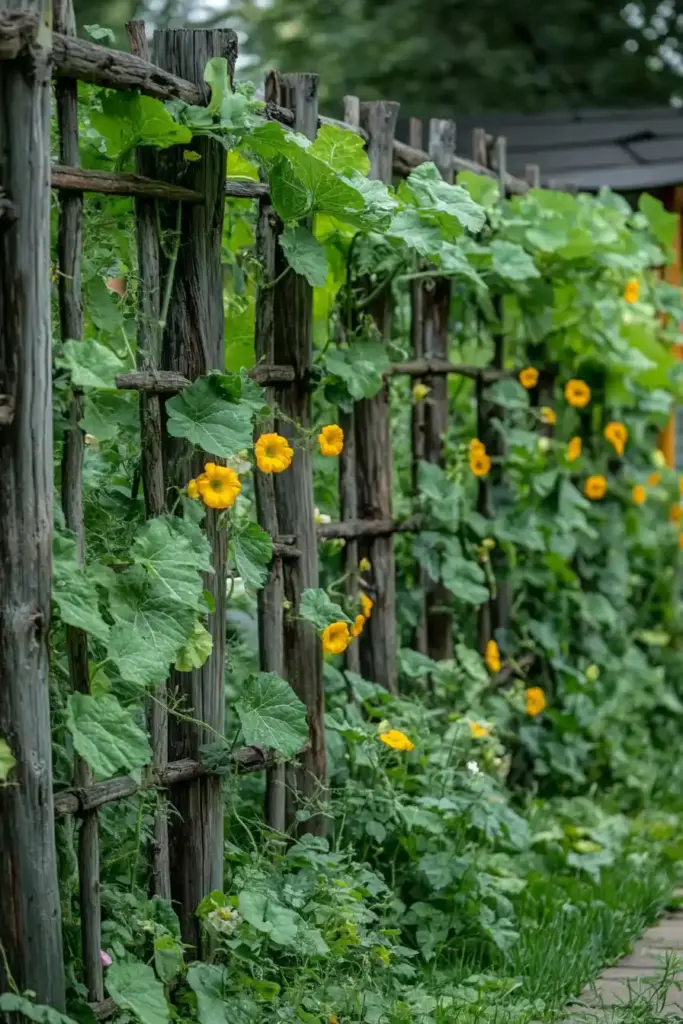
Overview:
A favorite among experienced gardeners, cattle panels are large metal grids that make excellent long-term trellises—sturdy, affordable, and widely available.
Materials Needed:
- One cattle panel (16 feet by 4–5 feet)
- T-posts or wooden stakes
- Zip ties or strong wire
Instructions:
- Bend the panel into an arch or install it upright.
- Secure each end to T-posts or wood stakes with zip ties or heavy-duty wire.
- Plant cucumbers on both sides and guide vines through the panel.
Pros:
- Extremely durable and weather-resistant
- No need for twine or additional supports
- Great for high yields
Cons:
- Can be tricky to bend without help
- Not the most aesthetic option
13. Recycled Tiki Torch Cucumber Trellis
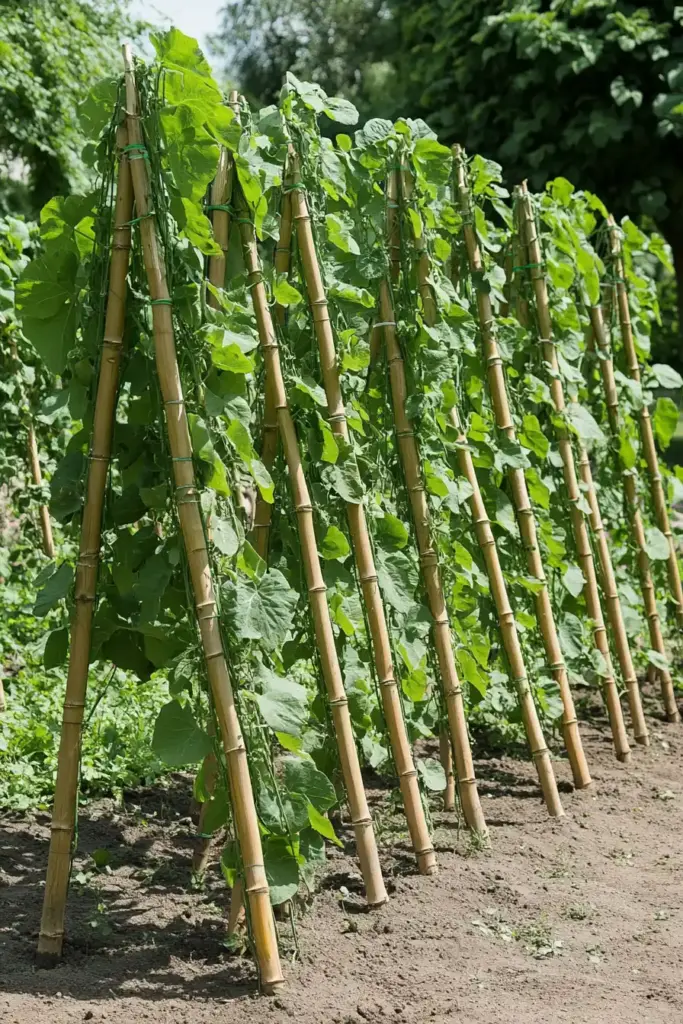
Overview:
Got old or broken tiki torches lying around? Give them a second life as garden trellis supports. This creative and eco-conscious idea adds flair while helping your cucumbers climb.
Materials Needed:
- 3–4 old tiki torches (wood or bamboo)
- Garden twine or jute
- Zip ties (optional)
Instructions:
- Insert tiki torches into the soil in a triangle or square layout.
- Tie twine between the torches to create a web or grid.
- Optionally, reinforce with zip ties or additional crossbars.
- Plant cucumber seeds at the base and guide vines up the structure.
Pros:
- Great way to repurpose old items
- Adds tropical style to the garden
- Easy and inexpensive
Cons:
- Not as strong as purpose-built materials
- Wood torches may degrade over time
14. DIY Container Cucumber Trellis
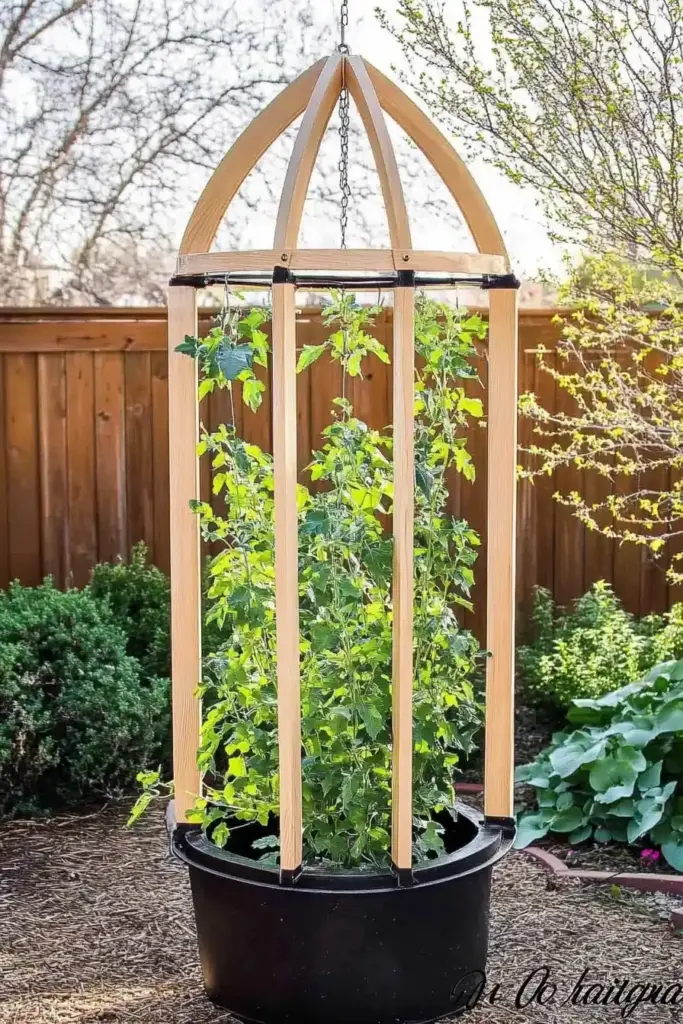
Overview:
Perfect for patio or balcony gardeners, this container-friendly trellis gives your cucumbers vertical space without needing ground soil.
Materials Needed:
- Large garden container or grow bag
- Bamboo stakes, wire frame, or tomato cage
- Twine or netting (optional)
Instructions:
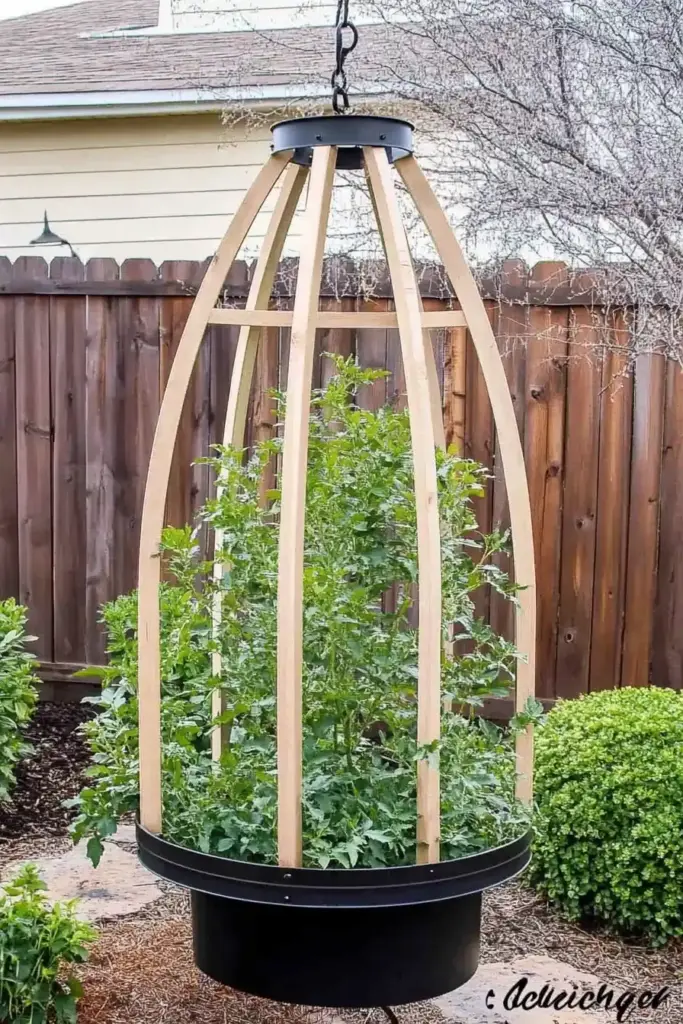
- Fill your container with potting mix and place the trellis directly into the soil.
- Use a cage, teepee of bamboo stakes, or a mini A-frame to support vines.
- Plant cucumbers at the base and tie the vines gently as they grow.
Pros:
- Ideal for small-space or urban gardeners
- Moveable and flexible
- Easy to set up and maintain
Cons:
- May require frequent watering in containers
- Limited space for large cucumber varieties
15. DIY Tomato Cage Trellis
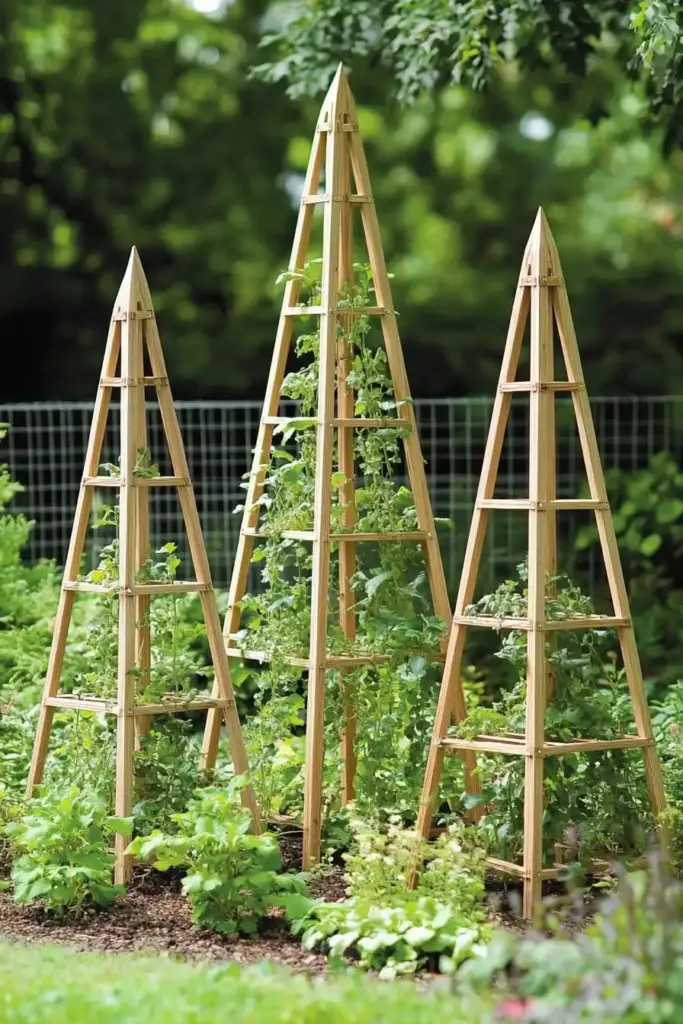
Overview:
Tomato cages aren’t just for tomatoes — they’re also great cucumber supports when used creatively. This is one of the fastest DIY solutions out there.
Materials Needed:
- Tomato cage (round or square)
- Garden twine (optional)
- Container or in-ground placement
Instructions:
- Place the tomato cage over your cucumber plant or insert it at planting time.
- Use twine to add extra vertical or horizontal supports if needed.
- Guide vines through the cage as they grow.
Pros:
- Already built — just place and plant!
- Lightweight and portable
- Great for containers or garden beds
Cons:
- May not support large harvests
- Not the most attractive option for decorative gardens
16. A-Framed Pallet Cucumber Trellis
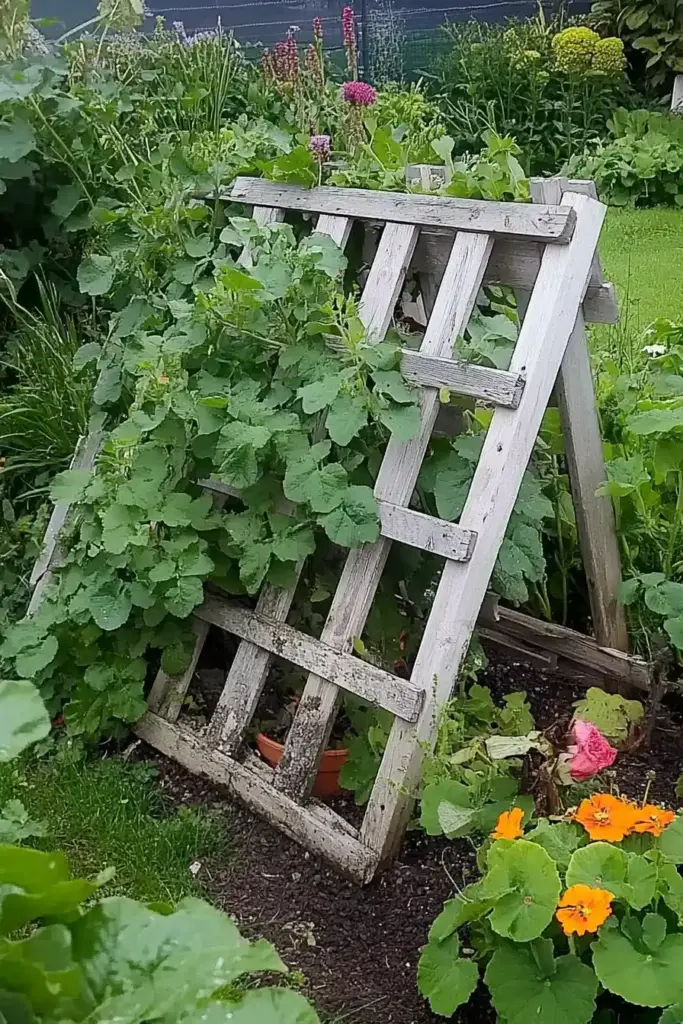
Overview:
This upcycled A-frame uses two wooden pallets leaned together to create a sturdy, rustic trellis that doubles as a garden feature.
Materials Needed:
- Two heat-treated (HT-stamped) wood pallets
- Screws or brackets (optional)
- Twine or garden netting (optional)
Instructions:
- Lean two pallets together to form an A-frame shape.
- For added stability, secure at the top with screws or brackets.
- You can also add netting or twine across the slats for more climbing support.
- Plant cucumbers at the base of each side.
Pros:
- Reuses materials that would otherwise go to waste
- Very sturdy and wind-resistant
- Provides plenty of growing space
Cons:
- Requires space due to its bulk
- Pallets must be chemical-free (look for HT marking)
Final Thoughts 🌿
With these 16 DIY cucumber trellis ideas, there’s something for every gardener — whether you want a rustic vibe, a modern look, or a simple solution with what you already have. Vertical gardening not only saves space but also leads to healthier plants and easier harvests.
Choose the design that fits your space, tools, and style, and you’ll be harvesting crispy cucumbers in no time!

